|
Red, Not Blue
The Mid-Atlantic's Other Big Crab
Scientists get a rare glimpse of a mysterious deep-sea crustacean
Daniel Strain
A deep-sea red crab hangs out on a bubblegum coral. Credit: NOAA Okeanos Explorer Program
THE WEATHER TOOK A DOWNTURN, and white-topped waves tossed around the Hannah Boden. It was September 2014, and the fishing vessel was motoring along the Atlantic coastline of Virginia, hunting for a type of crustacean called the Atlantic deep-sea red crab (Chaceon quinquedens). These crustaceans live in the depths of Norfolk Canyon, a submarine gorge that begins about 60 miles off the mouth of the Chesapeake Bay and extends far below the ocean's surface.
On board the boat, crustacean biologist Bradley Stevens struggled to keep his gear from scattering across the bucking deck. The scientist had hitched a ride in order to collect samples of the same crabs. He was no stranger to bad weather. Stevens had worked for more than 20 years as a fisheries biologist in Alaska where he kept an eye on populations of king crabs, monster crustaceans that live in the Bering Sea. There, he spent days out on the water, sailing on the sorts of boats made famous on Deadliest Catch, the reality show that depicts the rough seas and dangerous conditions that fishing crews face on the Bering Sea. But the conditions onboard the Hannah Boden were worse.
"We had eight-foot waves, and the wind was blowing," says Stevens, now a professor at the University of Maryland Eastern Shore in Princess Anne. "I thought to myself, 'Why am I doing this? Why did I leave Alaska to come here and do this?'"
It was a good question: the biologist is among the few scientists who study Atlantic red crabs. These crustaceans, with orangish-red shells and spindly legs, are bigger than the blue crabs (Callinectes sapidus) living in the Chesapeake Bay. But, as Stevens's journey on the Hannah Boden shows, they're also hard to get to. The crabs scuttle along the sea floor at depths of 600 feet to more than a mile below the surface. And unlike their shelled relatives in the Bay, red crabs are virtual unknowns: what they eat, how they reproduce, and what role they play in the deep sea's ecology are all unanswered questions.
Stevens is trying to gather basic data about how red crabs eke out a living in the cold ocean. He hopes this information will become useful as red crabs face a number of challenges in the future. Those challenges include warming ocean temperatures and fishing pressure from boats like the Hannah Boden, which procure crabmeat for a niche seafood market.
Red crabs "are so poorly studied, and that means there are lots of things we can learn," Stevens says. "Sometimes just getting your hands on them can give you new information."
Life in the Deep
You can think of these elusive animals as Maryland's other big crab. One of several related species of crustaceans that live in various deep stretches of the Atlantic, red crabs flank the edge of the continental shelf from Nova Scotia south to the Gulf of Mexico. Blue crabs are called swimming crabs because they can use their paddle-like rear legs to propel themselves through the water. But red crabs have no choice but to walk along the seafloor. Most live at greater depths than do the king crabs Stevens studied in Alaska, surviving in habitats that are "at the frontiers of our understanding" of the oceans, says Richard Wahle, a marine biologist at the University of Maine.
This sparse environment makes the Chesapeake Bay look like a spa: at these depths, there's little to no light to navigate by, and water temperatures hover around 38 degrees Fahrenheit. Sustenance can be hard to come by, too, says Wahle, who has also studied red crabs. Like other deep-sea animals, these crustaceans often depend on food that sinks down from the surface. The carcasses of dead whales, for example, serve up a nutrition bonanza that the crabs can sniff out from long distances away. "They're very tuned into their chemical environment," he says. "They can hone in on these sources of food like oases in the desert."
Scientists have made sporadic attempts to view red crabs in their natural habitat. For a study published in 2008, Wahle used a camera towed on an underwater sled to capture images of red crabs scuttling about in the deep. But such efforts are expensive and few and far between. Which is why, for Bradley Stevens, the Okeanos Explorer presented a new opportunity.
Predation in the Deep Sea
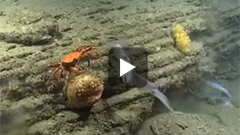
An Atlantic deep-sea red crab in Norfolk Canyon attempts to grab a meal. The video was shot by a remotely operated underwater vehicle launched by NOAA's Okeanos Explorer research vessel in 2014.
Stevens got help in fall 2014 from the crew of the research vessel, which is operated by the National Oceanic and Atmospheric Administration (NOAA). The Okeanos Explorer participated in a series of research expeditions in recent years that investigated the Atlantic's deep-sea habitats (see The Grand Canyons off Our Coast). The Okeanos crew lowered a camera-equipped, remotely operated underwater vehicle, or ROV, on nine dives that probed the Atlantic's underwater gorges, including Norfolk Canyon. This robotic explorer was more maneuverable than Wahle's sled-mounted camera. The ROV could swivel and home in on objects of interest and pipe its video footage live to computers on land.
Stevens, who had moved to Maryland in 2009, saw a chance to collect valuable data on red crabs. He assigned his students to watch the mission footage in two-hour shifts as it streamed in real-time on their lab computer. Each dive started at 8 a.m. and wrapped up at around 4:30 p.m., and for those hours, Stevens and his students stayed glued to the computer screen.
As the ROV explored the underwater canyons, the students spied expanses of muddy bottom and sites where corals clung to rocky cliff faces. If the students spotted a crab, they sent a message to the Okeanos team, which recorded the observation in the mission's official log.
"When they were doing the dives in the Norfolk Canyon, it was super interesting because there were red crabs all the time," says Stephanie Martinez-Rivera, a graduate student in Stevens's lab who participated in the watch.
Some of the most important information that Stevens and his students collected, however, was basic data: where the red crabs lived and under what water temperatures. Such information is critical, Stevens says, because the oceans are changing. Even in the cold depths where red crabs live, water temperatures are likely to heat up in the coming decades because of climate change. That, in turn, could have consequences for red crabs. Warming waters could force the crustaceans into new habitats or shift when they time key events in their lives, such as when they reproduce.
Red Crab Fishing
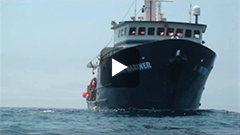
In this video, fishermen haul in and process deep-sea red crabs aboard the F/V Benthic Mariner, part of the Atlantic Red Crab Company's fleet.
It's a phenomenon that scientists have seen before: every summer around July, American lobsters (Homarus americanus) in New England stage a mass migration from their deeper water habitats toward the shore. In 2012, however, an ocean heat wave hit the East Coast, and lobsters wound up making their move three weeks earlier than normal. That year, commercial fishermen caught a record number of crustaceans. Without basic data, however, scientists would have no idea if something similar happened to red crabs.
"I'm hoping that we'll be able to set some baselines and look back on them in 20 or 30 years and say, 'Oh, these cycles have changed,' or 'the temperature environment has changed,'" Stevens says.
But warming waters aren't the only uncertainty in the red crab's future. Another comes in the form of a crab trap.
Crab Alfredo
Like the crustacean biologist, Jon Williams got his start with king crabs in Alaska. In his case, he was harvesting them from boats in the Bering Sea. Looking for work a little closer to home, the Maine native got a job in the mid-1990s working for a relatively new industry: the red crab fishery. Today, Captain Williams owns the Atlantic Red Crab Company, the sole harvester of deep-sea red crabs in North America.
His operation is a modest one: the company operates four boats, which sail throughout the year. Three of them are based in New Bedford, Massachusetts, while the fourth — the same Hannah Boden that carried Stevens into the fall storm — docked in Newport News, Virginia, in 2014 and 2015. The four boats target deep-sea habitats between New England and the Mid-Atlantic Bight, including canyons off the coast of Maryland.
Some of the gear differs, but hunting for red crabs is similar work to harvesting king crabs. Williams's crews drop lines of 150 crab traps, bigger than those used by crabbers in the Bay, down to the sea floor. When his crew pulls the traps back up, they can collect thousands of crabs in a single go. Every year, his boats bring in about three million pounds of red crabs valued at roughly $3 million. That's a small sum compared the $50 million worth of blue crabs caught annually by watermen in Maryland.
|
Red Crab
Chaceon quinquedens
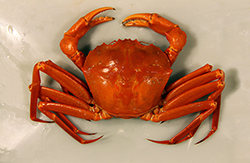
Brad Stevens/UMES
|
Blue Crab
Callinectes sapidus
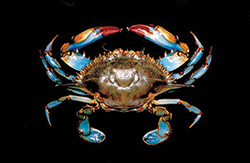
Iain McGaw and Carl Reiber
|
|
Geographic range: Nova Scotia to the Gulf of Mexico
|
Geographic range: Nova Scotia to Argentina
|
|
Depth range: 600 feet to 5,800 feet
|
Depth range: Maximum of about 290 feet
|
|
Key distinguishing characteristics: Relatively small carapace (up to 7 inches wide); long legs and no swimming paddles; maximum weight of about 3.75 pounds
|
Key distinguishing characteristics: Wide carapace (up to 9 inches); short legs with swimming paddles on the hindmost legs; maximum weight of about one pound
|
|
Life span: Up to 15 years
|
Life span: Usually not longer than 3 years
|
|
Reproduction: Unlike most deep-sea crabs, female red crabs do not produce offspring annually and may reproduce only once every two years
|
Reproduction: Females mate once in their lives; they store the sperm and may produce offsprings in multiple years
|
|
Larval dispersal: Newly hatched larvae (zoeae) likely swim to surface waters, returning to the deep sea as megalopae (juveniles)
|
Larval dispersal: Newly hatched (zoeae) in the Chesapeake Bay ride currents to the open ocean, returning to the estuary as megalopae (juveniles)
|
|
Sources: NOAA (red crab); NOAA, Fisheries and Aquaculture Organization of the United Nations (blue crab)
|
Without knowing it, you may have eaten red crab meat. During the early years of his business, Williams sold his harvest exclusively to the Red Lobster restaurant chain. "We were the crab in the Crab Alfredo," he says, at least until the chain phased out the dish in 2008 because of changing tastes. Today, Williams works with a number of different seafood wholesalers both in the United States and in Asia. One client shipped 3,000 pounds of red crabs every week by plane from New York to Asia — the animals alive and in specially cooled tanks — to satisfy a growing demand for seafood overseas.
At home, it's hard to compete with staples like blue crabs, even if red crabs, Williams says, have a sweeter-tasting meat. "To be honest, it's a tough sell," the captain says. Seafood consumers want "what they've always had."
As with all fisheries, the government has a stake in ensuring that the Atlantic Red Crab Company doesn't deplete the supply of these sweet-tasting crustaceans to unsustainable levels. In this case, a regulatory group called the New England Fishery Management Council sets a limit on how many crabs Williams can catch in a year: four million pounds of males, and no females. That's about one million more pounds of crab than Williams has caught in recent years — largely because the market won't support a bigger haul.
But what's different about the red crab harvest, Bradley Stevens says, is that it's what scientists call a "data-poor" fishery. In ideal circumstances, limits for fisheries are based on solid data: there are, for instance, so many mature crabs in a population, and they produce a certain amount of offspring in a year. That, in turn, can help to tell you how many crabs you can catch each year without depleting the stock. For red crabs, however, much of that biological information is missing. That makes the fishing quota more of "a gentleman's agreement between NOAA and the catcher-processor," Stevens says.
Based on the limited, existing data, scientists believe the fishery isn't in peril. One 2008 survey of red crabs, conducted by Richard Wahle, the marine biologist from Maine, reported that the number of red crabs in the Atlantic hadn't declined from the 1970s to the 2000s. In fact, there seemed to be more crabs around than there were before Williams started his operation.
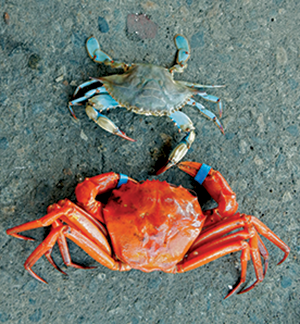
Brad Stevens/UMES
Still, Stevens says that it's important to bring more biology to the management of the red crab fishery. To that end, he and his students are collaborating with Captain Williams to collect and study red crabs from the deep. They're asking basic questions like at what size, for example, do female and male crabs reach maturity. This sort of information not only satisfies the scientists' curiosity. It could also help fisheries managers to develop more finely-tuned regulations for the red crab harvest that could ensure the sustainability of the fishery into the future.
As for Stevens, he says he still gets those "why-am-I-doing-this?" moments.
"I'm always somewhat envious of my colleagues who work on things that are in shallow water," Stevens says. "I'm trying to study this animal that is out there in 2,000 feet of water."
Daniel Strain, formerly a science writer with Maryland Sea Grant, now lives in Denver, Colorado, where he writes occasional articles for Chesapeake Quarterly.
|